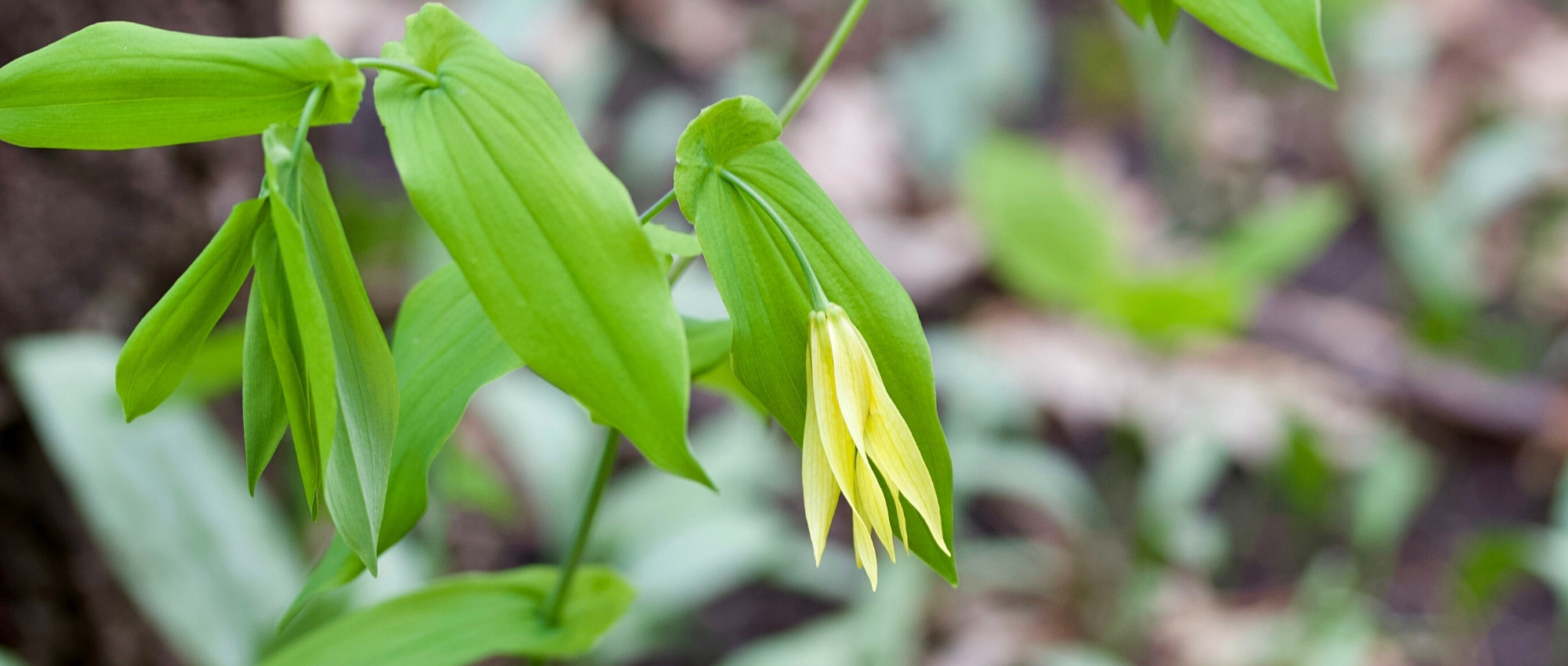
Uvularia: planting, growing and care
Contents
Uvularia in a few words
- Uvularia is a shade-loving perennial that produces delightful yellow, bell-shaped trailing flowers in spring.
- It boasts beautiful, tender green foliage, resembling that of Solomon’s Seal.
- This rare and little-known plant will delight collectors and curious gardeners alike.
- It thrives in woodland settings, alongside ferns, hostas, epimediums, and other shade-loving perennials.
- Its flowering brightens up woodland areas and shady corners of the garden!
- It prefers cool, light, humus-bearing soils, preferably acidic.
The word from our expert
The Bellwort, Uvularia grandiflora, is a herbaceous perennial native to North America, featuring lovely tender green foliage reminiscent of Solomon’s Seal. Its arching stems bear stunning yellow bell-shaped flowers in spring, from April to May, which nod gracefully towards the ground. Its flowering is incredibly delicate and humble, composed of six long, spiralled petals. The variety Uvularia grandiflora ‘Pallida’ stands out with its softer, paler cream-yellow flowers.
The Bellwort is still a relatively unknown plant, yet it boasts remarkable ornamental qualities. Its flowering brightens up woodland areas and shady corners of the garden! It thrives in cool, humus-bearing, slightly acidic soil and pairs beautifully with heather soil-loving bushes. This low-maintenance plant primarily requires the soil to remain moist year-round, even in summer. In a natural woodland-style garden, it is perfect alongside ferns, hostas, brunneras, and epimediums. It can also adapt to container gardening, making it ideal for shaded patios or balconies. Discover all our tips for successfully growing Bellwort in this guide!
Botany
Botanical data
- Latin name Uvularia grandiflora
- Family Colchicaceae
- Common name Uvularia, Yellow Fairy Bells
- Flowering April-May
- Height between 40 and 70 cm
- Sun exposure shade or partial shade
- Soil type moist, humus-bearing, slightly acidic
- Hardiness -15 to -20 °C
Uvularia is a herbaceous perennial with a rootstock, native to eastern North America (Canada and the United States), where it grows in woodland understories. It is therefore a shade-loving plant that thrives in moist, humus-bearing, slightly acidic soils. It is quite hardy, tolerating temperatures as low as -15 to -20 °C. There are 5 species of Uvularia, all endemic to North America, but it is primarily Uvularia grandiflora that is cultivated. However, it remains relatively rare in cultivation and is seldom seen in gardens, despite its ornamental qualities and ease of cultivation.
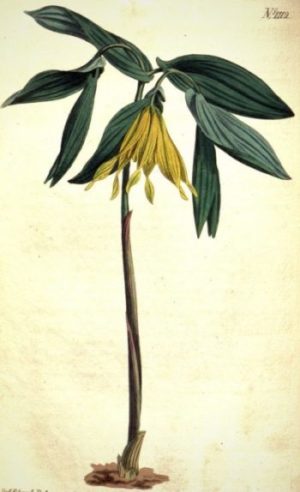
Uvularia grandiflora: Botanical illustration
Although it does not belong to the same family, Uvularia shares similarities with Solomon’s Seal (Polygonatum). It thrives under the same growing conditions—moist, humus-bearing, slightly acidic soil in woodland settings. Both grow from a rootstock and feature arching stems with similar oval, lanceolate, deciduous foliage and bell-shaped, trailing flowers—yellow in Uvularia and white in Solomon’s Seal.
Uvularia also closely resembles Disporum, an Asian woodland perennial. Both plants are nicknamed “Fairy Bells.” They belong to the same family (along with Gloriosa and Sandersonia): the Colchicaceae.
The genus name comes from the Latin uvula, meaning “little grape,” referring to how the flowers hang downward. The species name grandiflora means “large-flowered.”
Uvularia grows from its rootstock and forms clumps of simple or ramified stems, initially upright but arching at the top and trailing. It reaches between 30 and 70 cm in height and spreads 30 to 40 cm wide. Uvularia grows slowly and spreads slightly via its rootstock without becoming invasive.
Uvularia blooms in spring, from April to May. The flowers appear terminally at the ends of the stems, which arch slightly under their weight. They are solitary or paired, borne on long peduncles. The flowers are yellow, trumpet-shaped, 4 to 5 cm long, and inclined toward the ground. They are tubular and composed of 6 long, free tepals (3 sepals and 3 petals, all identical in appearance), each elegantly twisted in a spiral. The flowers contain nectar and are favoured by bees and bumblebees, which ensure their pollination.

The flowering of Uvularia grandiflora: overview and detail of the flower. Note the spiralled petals twisting on themselves. (photos: Krzysztof Ziarnek / Eric Hunt / Heiditoronto)
The foliage of Uvularia fully develops after flowering and remains decorative throughout the summer. It disappears in autumn, as Uvularia is a deciduous plant and enters dormancy.
Uvularia has very attractive foliage, resembling that of Solomon’s Seal. The leaves, 8 to 10 cm long, are oval-lanceolate, a lovely soft green colour, and downy on the underside. They are inserted alternately on the stems (one after the other) and are perfoliate: the stem passes through the lamina.
The fruits of Uvularia are curious triangular capsules containing small, round, brown seeds. The seeds have small protuberances called elaiosomes, which attract ants. The ants carry the seeds to feed their larvae, and once the larvae consume the elaiosome, the ants store the seeds with other waste in the anthill, allowing the Uvularia seeds to germinate in a nutrient-rich environment.

Young shoots of Uvularia starting growth in spring, fully developed foliage, and a capsule containing seeds (photos: Salicyna / Sonnia Hill / Krzysztof Ziarnek)
The main varieties of Uvularia
The Most Popular Varieties
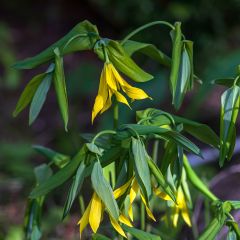
Uvularia grandiflora
- Flowering time May, June
- Height at maturity 40 cm
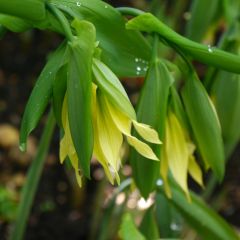
Uvularia grandiflora var. pallida
- Flowering time May, June
- Height at maturity 40 cm
Discover other Uvularia
View all →Available in 1 sizes
Available in 2 sizes
Planting
Where to Plant?
Uvularia is a woodland plant that thrives in shade or partial shade. You can place it at the base of trees or bushes, alongside other small shade-loving perennials (hostas, ferns, brunneras, epimediums, trilliums…), to create a very natural scene. Like most forest plants, it prefers humus-bearing, light, loose, and well-aerated soils that remain cool even in summer. It dislikes compact and clayey soils where water stagnates in winter. If your soil is heavy, improve it by adding organic matter: leaf mould, well-rotted manure, mature compost… Uvularia has a preference for acidic soils, making it an easy fit for a heather soil bed. It can also be grown in a large pot or container, placed on a terrace or balcony, in the shade.
When to Plant?
Plant Uvularia in early spring (March-April) or autumn (September-October). The most important thing is to avoid periods of frost or extreme heat.
How to Plant?
If planting multiple young plants, space them at least 30 cm apart.
- Soak the root ball in a basin of water to rehydrate it.
- Dig a large planting hole, two to three times the size of the root ball.
- Add well-rotted compost and, optionally, a bit of heather soil, mixing it with the planting soil.
- Place the Uvularia in the centre of the planting hole.
- Backfill with soil around the plant, gently firming it to ensure good contact between the soil and the roots and to avoid air pockets.
- Water generously.
- Apply a layer of organic mulch around the root ball (dead leaves, straw…). This will help prevent the soil from drying out too quickly while also limiting weed growth.
Continue to water regularly in the weeks following planting.
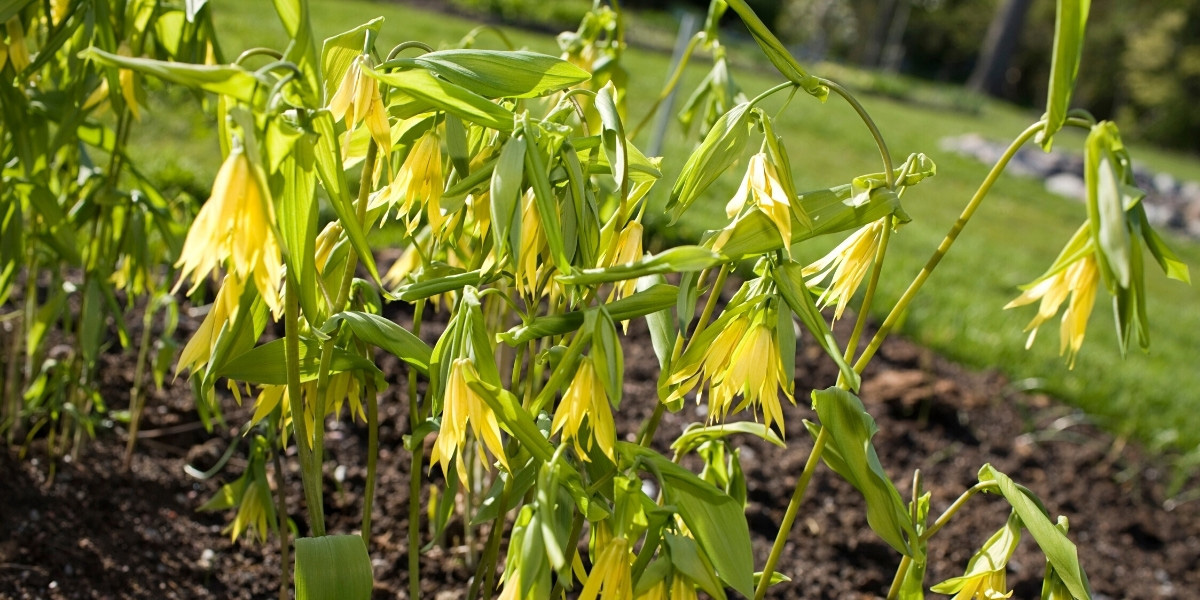
Uvularia grandiflora
Maintenance
The Uvularia requires very little maintenance. It is a perennial and very hardy plant, capable of withstanding occasional temperatures as low as -20°C. However, it is sensitive to drought and needs the soil to remain relatively moist throughout the year, even in summer. We recommend applying a layer of organic mulch (dead leaves, straw, wood chips, etc.) around its base to keep the soil cool and to water occasionally during dry spells. Be particularly vigilant during the first year to ensure it doesn’t lack water while it establishes itself.
We advise marking its location with a stake or label to avoid trampling the stump in autumn and winter when its foliage has disappeared.
Feel free to add a little well-rotted compost around its base each year to enrich the soil.
In spring, slugs and snails can cause significant damage as they are fond of the young leaves of Uvularia. Stay alert and protect your young plants when the first shoots emerge in spring.
Propagating
Uvularia can be propagated by sowing or dividing clumps.
Sowing
Sowing is done in autumn.
- Prepare a pot by filling it with special sowing compost.
- Lightly firm and level the surface.
- Sow the seeds by scattering them on the surface.
- Cover with a thin layer of compost.
- Water gently with a fine spray.
- Place the pot under a cold frame, in a bright spot but out of direct sunlight.
Ensure the substrate remains slightly moist until germination. Be patient, as the seeds can take up to 6 months to germinate.
Once the seedlings are large enough to handle, you can transplant them into individual pots.
Dividing Clumps
As Uvularia is a rhizomatous plant, dividing clumps by cutting the rootstock is quite straightforward. Division is best done in late winter.
- Choose a well-established clump that has been growing for several years.
- Dig it up using a spade, taking care to dig wide enough to avoid damaging the roots.
- Remove excess soil to expose the rootstock.
- Divide the clump into several sections by cutting the rootstock, ensuring each new clump retains some roots.
- Replant in pots or a new location after preparing the soil.
- Water generously.
Association
Since Uvularia is a shade-loving plant, it will be perfect in a woodland garden to create a natural atmosphere alongside ferns such as Dryopteris wallichiana or Blechnum spicant, as well as with hostas, epimediums, and brunneras… Also consider the beautiful flowering of bluebells, Hyacinthoides non-scripta, which offer charming little blue bells in April-May. Discover also the Trillium grandiflorum, which boasts beautiful flowers composed of three pure white petals. Take inspiration from plants found naturally in French woodlands, such as cowslips Primula veris, comfrey, lungwort, and ferns.
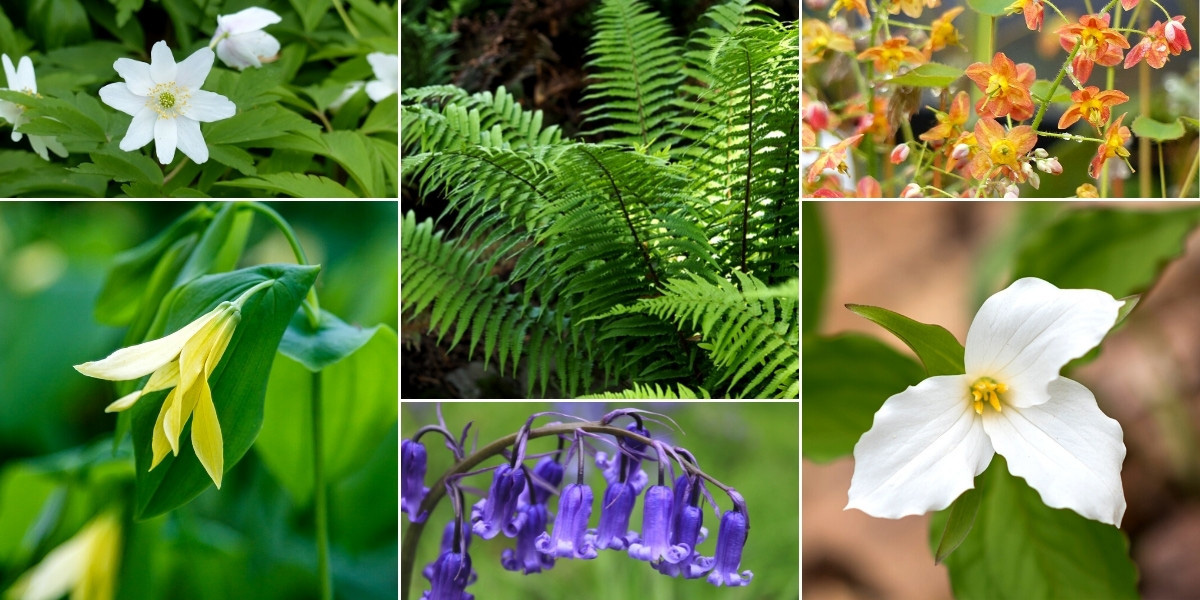
Uvularia easily finds its place in a shaded woodland garden! Anemone nemorosa ‘Lychette’, Dryopteris wallichiana, Epimedium pubigerum ‘Orangekönigin’, Uvularia grandiflora, Hyacinthoides non-scripta, and Trillium grandiflorum
Thriving in acid soils, Uvularia will integrate effortlessly into a heather soil bed, alongside acidophilous bushes: rhododendrons and azaleas, Pieris japonica, Skimmia, Andromeda polifolia, and camellias. Enjoy the striking and highly decorative foliage of a Japanese maple. You can also incorporate the heather Erica darleyensis ‘Spring Surprise’, which will delight you in spring with its countless tiny pink flowers!
Uvularia can also find its place at the feet of spring-flowering bushes, such as Exochordas, Judas trees, Japanese quinces, and flowering cherries like the stunning Prunus serrulata ‘Kiku Shidare Zakura’. You can also pair it with spring bulbs: daffodils, muscari, fritillaries, tulips…
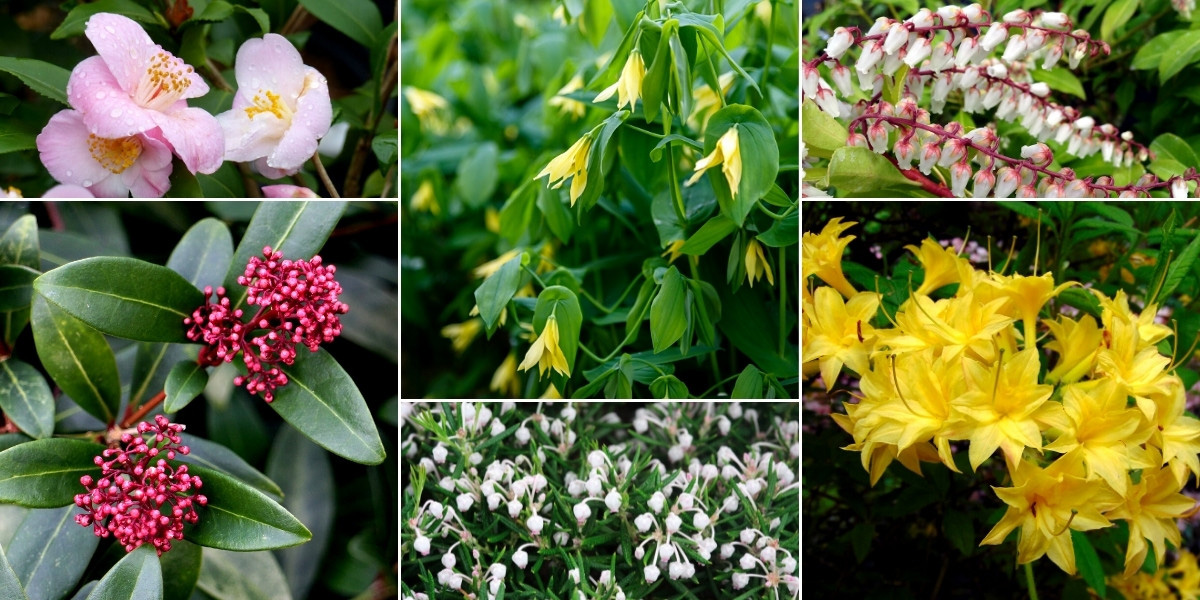
Don’t hesitate to pair Uvularia with heather soil bushes. Camellia ‘Cinnamon Scentsation’, Uvularia grandiflora, Pieris japonica ‘Mountain Fire’, Skimmia japonica ‘Rubella’, Andromeda polifolia ‘Nikko’, and Azalea ‘Narcissiflora’
→ Discover more ideas for pairing with Uvularias in our advice sheet!
Useful resources
- Discover our range of Uvularia
- To pair with Uvularia, explore our selection of shade-loving perennials, heather soil bushes, and spring bulbs
- For an exceptional garden filled with botanical curiosities, discover all our rare and collectible perennials
- Subscribe!
- Contents

































Comments